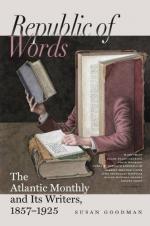Here, at the tomb of Lorenzo, are three masterly figures. An heroic, martial, deeply contemplative figure sits in grand repose. A statesman, a sage, a patriot, a warrior, with countenance immersed in solemn thought, and head supported and partly hidden by his hand, is brooding over great recollections and mighty deeds. Was this Lorenzo, the husband of Madeleine, the father of Catharine? Certainly the mind at once dethrones him from his supremacy upon his own tomb, and substitutes an Epaminondas, a Cromwell, a Washington,—what it wills. ’Tis a godlike apparition, and need be called by no mortal name. We feel unwilling to invade the repose of that majestic reverie by vulgar invocation. The hero, nameless as he must ever remain, sits there in no questionable shape, nor can we penetrate the sanctuary of that marble soul. Till we can summon Michel, with his chisel, to add the finishing strokes to the grave, silent face of the naked figure reclining below the tomb, or to supply the lacking left hand to the colossal form of female beauty sitting upon the opposite sepulchre, we must continue to burst in ignorance. Sooner shall the ponderous marble jaws of the tomb open, that Lorenzo may come forth to claim his right to the trophy, than any admirer of human genius will doubt that the shade of some real hero was present to the mind’s eye of the sculptor, when he tore these stately forms out of the enclosing rock.
A colossal hero sits, serene and solemn, upon a sepulchre. Beneath him recline two vast mourning figures, one of each sex. One longs to challenge converse with the male figure, with the unfinished Sphinx-like face, who is stretched there at his harmonious length, like an ancient river-god without his urn. There is nothing appalling or chilling in his expression, nor does he seem to mourn without hope. ’Tis a stately recumbent figure, of wonderful anatomy, without any exaggeration of muscle, and, accordingly, his name is——Twilight!
Why Twilight should grieve at the tomb of Lorenzo, grandson of Lorenzo Magnifico, any more than the grandfather would have done, does not seem very clear, even to Twilight himself, who seems, after all, in a very crepuscular state upon the subject. The mistiness is much aided by the glimmering expression of his half-finished features.
But if Twilight should be pensive at the demise of Lorenzo, is there any reason why Aurora should weep outright upon the same occasion? This Aurora, however, weeping and stately, all nobleness and all tears, is a magnificent creation, fashioned with the audacious accuracy which has been granted to few modern sculptors. The figure and face are most beautiful, and rise above all puny criticism; and as one looks upon that sublime and wailing form, that noble and nameless child of a divine genius, the flippant question dies on the lip, and we seek not to disturb that passionate and beautiful image of woman’s grief by idle curiosity or useless speculation.




